Assemblage & LIGHT ART (1)
My assemblage and light art pieces explore retro-futuristic and post-apocalyptic themes, incorporating found objects — predominantly technical artifacts — dating back 50 to 120 years.
Antique technical devices and rare curiosities, once symbols of innovation, have been stripped of their original purpose, relegated to the status of worthless detritus or the obscurity of forgotten collector's items gathering dust on cellar shelves.
Through my artistic process, I recontextualize these found objects, transforming them into evocative works of art — some imbued with the eccentric allure of sacred cult artifacts, others unsettling, and still others capable of eliciting a knowing smile.
My works inevitably evoke emotions, awaken childhood memories, and inspire contemplation — on the transience of objects and the inevitability of change.
Light plays a central role in my creations. The warm, reddish glow reminiscent of bygone eras — evoking hearths and nostalgia — stands in contrast to the cold, blue luminescence symbolizing technology and the future.
These contrasts — of light, form, material, and structure — generate dynamic tension, amplifying the expressive power of my artworks. I invite you to explore my gallery and, ideally, find it both thought-provoking and inspiring.

#SelfTracking
November 2024
60cm hight
#SelfTracking is the phenomenon of measuring and sharing of all kinds of physical and personal metrics.
In my assemblage artwork, I explore the theme of self-tracking.
An old thermograph from the 1950s forms the frame and records measurements on the rotating drum scale. Trapped in a cage of technology, the human being—symbolized by the 1940s Schildkröt doll's head—allows all sorts of measurements to be recorded. The two blue cold cathode tubes represent antennas, as the tracking of the measurements is shared with the whole world. The red light represents the pressure under which the person has placed themselves.
Thermograph: 1950s, Feingerätebau Fischer, Drebach / Erzgebirge, Germany
Doll head: 1940s, Strampelchen doll by Schildkröt
LED illumination: COB LED stripe, RGB changing LED, blue LEDs (doll eyes)
CCFL tubes: Cold cathode fluorescent tubes 30cm, blue
and
Hard disk parts, Edison incandescent bulbs, Bakelite sockets, dimmer, switch, textile power cord
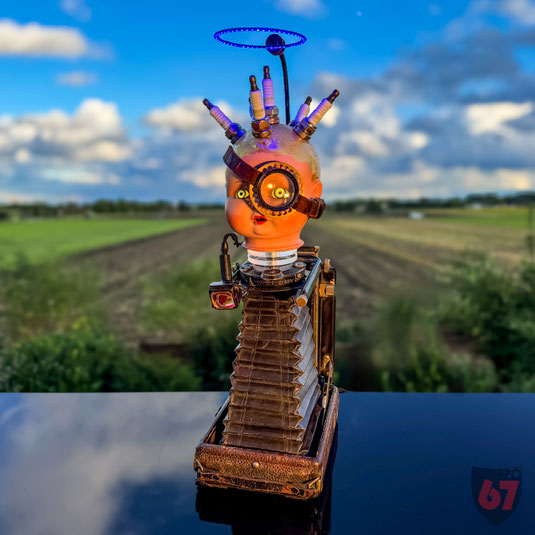
Strampelchen
July 2024
40cm height
This is my assemblage object art 'Strampelchen'.
Toddlers are often on the move all the time and kick their legs - they are always curious and want to explore their surroundings. I have symbolized this movement and curiosity in my art object with the leather bellows of the old camera, which is always in motion, with the shining eyes and the magnifying glass. The spark plugs show the firing of the neurons that represent the toddler's learning process.
The doll's head is a part of the doll series “Strampelchen” (a baby kicking its legs) which has been manufactured by Schildkröt in the 1940s.
The doll’s head sits on an antique plate camera
from 1923.
In this project I wanted to integrate not only
light, but also movement.
I built a geared motor into the leather bellows,
which drives an eccentric disk - this moves the bellows in slow rotations.
I have also integrated some LED lighting. Inside the doll's head, I have illuminated the glass eyes with LEDs. A blue LED ring floats above the old spark plugs. Finally, the camera's viewfinder is illuminated with a small red LED.
My upcycling works of art should always be a challenge for me, I don’t want to create the same thing twice - that would be too boring for me.

Intuition
June 2024
40cm height
Intuition is the ability to understand something immediately, without the need for reasoning or analysis. Intuition is an instinct, a gut feeling or is 'located' in the arms and legs, too.
I symbolize intuition with the butterfly and the light on the doll's head, with the light bulb in the belly, the tools on the hands and the rollers as feet in all directions.
I have used the head of a Schildkröt doll from the 1940s. The doll, called ‘Strampelchen’ (a baby that kicks its legs), is made of celluloid.
The body is an old measuring device from the 1940s
as well, spark plugs, porcelain insulators, wheels and old pliers. For the lighting, I used a very old beehive glow lamp and on top a 2024‘ flexible LED filament, powered by 3V.
The original glass eyes of the doll are illuminated from the inside with blue LEDs and it turned out really spooky.
One day a butterfly, a red admiral, lay dried up on our patio - for fun I put it on the doll’s head and it was the perfect combination.
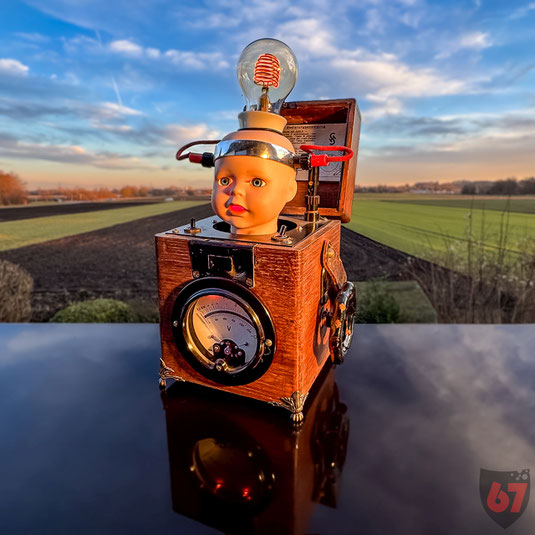
Brainwaves
May 2024
30cm height
This is my retrofuturistic assemblage »Brainwaves«.
Brainwaves are electrical impulses in the brain,
produced by synchronized neuron activity. They are categorized into different types, such as alpha, beta, delta, and theta waves, each associated with various states of consciousness and
cognitive functions.
The approx. 80-year-old porcelain doll‘s head was
the inspiration for this piece of art.
I added different sources of illumination, LEDs for the doll‘s eyes and an antique beehive neon glow bulb on top of the head.
This glow bulb has been developed for blackout
conditions in WW2. It is robust, provides orientation light and does not get hot.
Now it fits perfectly with the assemblage
Brainwaves.
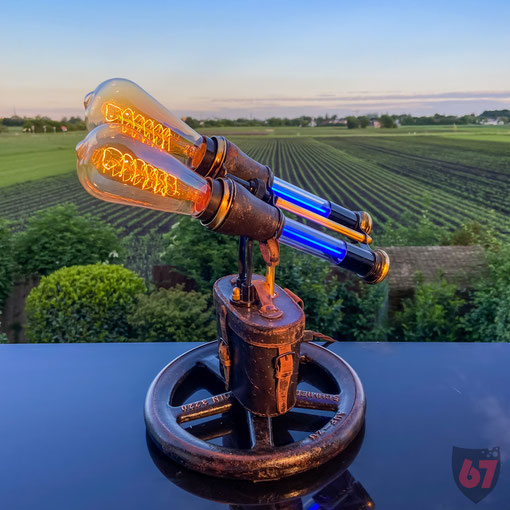
Antique binoculars upcycled to a lighting artwork
May 2022
30cm height
These binoculars or opera glasses were made around 1900 by Ernst Loewe in Zittau in Saxony. Unfortunately, no further information can be found on the net about this old manufactory of Ernst Loewe.
Brass and leather make the optical device a real gem. Whereby brass, leather and beautiful hardwood were the usual materials in former times - plastics or aluminum did not yet exist in suitable form and availability.
I have extended the binoculars with borosilicate glass tubes, so that there is room for 2 cold cathode tubes which produce a beautiful blue light. These 10cm long CCFL or cold cathode tubes have been used to illuminate PCs or car interiors before there were simple LED strips.
Instead of the front lenses I installed E27 sockets for two nice Edison bulbs.
In the leather quiver a dimmer, high voltage inverter, power supply and power switch have found perfect place.
I used an old heavy cast iron hand wheel for a stable stand.
So once again everything fits together fantastically and the old binocular remains a shining gem.
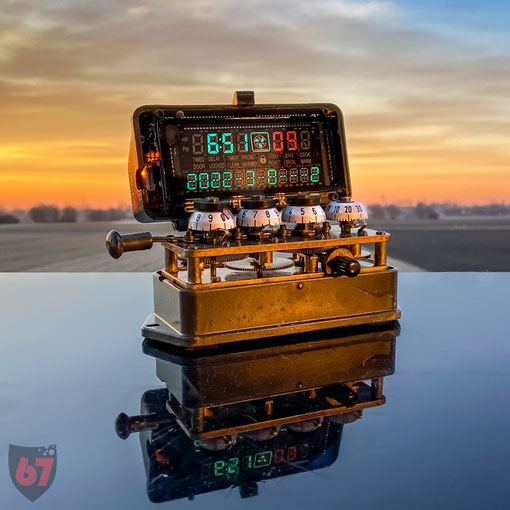
Upcycling artwork with 1950s mechanical counter and modern VFD clock display
March 2022
The origins of counting go back about 50,000 years in human history.
Later, it was the Sumerians as one of the first civilizations from about 4,000 BC who intensively used numbers and counting. People and goods were organized and counted.
Money and especially taxes were also counted with pleasure.
In my upcycling object I have combined a mechanical counter with a digital counter.
The mechanical counter of an unknown manufacturer from the 1950s uses gears with a 1:10 reduction to count the revolutions of an axle and display them by means of rotating indicator discs.
The mechanical counter was very dirty and the brass gears badly corroded. I took it all apart into its separate elements and polished it up. Then protected with clear lacquer.
The VFD display from the stove of a professional kitchen shows the time and date of a digital circuit with a quartz clock. Here, a quartz crystal is made to oscillate and this oscillation is counted and converted into seconds, minutes, hours, etc. by means of digital logic. The time is then displayed on a vacuum fluorescent display.
I found the VFD display module on AliExpress, it is powered by USB.
Now it’s a beautiful and practical piece of art for my desk.
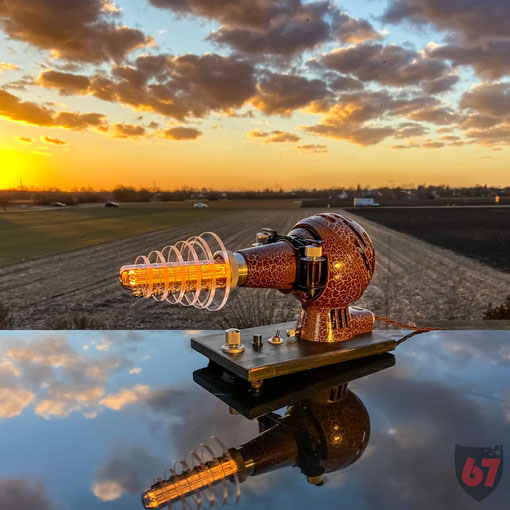
1950s Carl Zeiss Slide Projector turned into a retrofuturistic ray gun
February 2022
This slide projector from the 1950s is a wonderful example of how form and function can be brought into perfect balance.
The 'Kleinbildwerfer 100' was built in the early 1950s by Carl Zeiss, Jena.
Carl Zeiss was founded in 1846, specialized in optical systems and precision mechanics. Over 150 years later Carl Zeiss AG holds hundreds of patents, has 35,000 employees and has become an international corporation.
In the projector I have installed a glass sphere, which is illuminated red and blue. Instead of the front projection lens, there is now a special LED tube lamp with laser engraved structures.
The 6 acrylic glass panes around the tube create the retro-futuristic look of a ray gun.
Let your rays of light shine.

1960s Hickok Multimeter with giant Thyratron electron tube
June 2021
This gigantic 44cm electron tube has finally found a new use. The Thyratron tube is a high-voltage rectifier filled with mercury vapor made by 'VEB Werk für Fernsehelektronik Berlin' in the 1960s.
Invented in 1902 mercury vapor rectifier tubes were used to provide DC power for industrial motors, railways and locomotives as well as for power radio transmitters.
When the tube is shaken, a drop of mercury the size of a finger moves inside the glass bulb. It’s a good thing the glass is so stable.
The basis is an old Hickok multimeter from 1961, which was built for the US Navy and is not only waterproof, but also very robust. In 1910 Robert D. Hickok founded a small company to manufacture electrical measuring instruments. In 1913 'The Hickok Electrical Instrument Co.' moved to Cleveland, Ohio. A brief history of the company can be found here.
Other ingredients include isolators, Bakelite sockets, radio tubes, LED spots, Edison light bulbs etc.
In Flash Gordon, that would have fit perfectly in Dr. Zarkov‘s laboratory. You really have to see the old series from 1936 again.
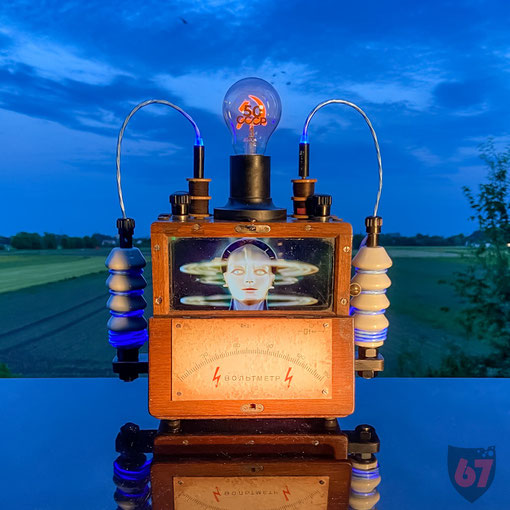
1940s Russian Voltmeter upcycling project with 7" Video Display
May 2021
I‘ve always wanted to install a modern video display in an antique device. An 80 year old Russian voltmeter and a 7 inch digital photo frame with video function was perfect for this.
Unfortunately the display module was 6mm too wide and you shouldn’t shorten a display. So I completely dismantled the antique wooden housing and created a little more space with the milling machine.
I wrapped two laboratory insulators with blue pulsating USB cables and put an old glow lamp on top. This neon glow lamp with hammer and sickle was produced in 1972 for the 50th anniversary of the Soviet Union CCCP. One electrode is hammer and sickle - the other electrode is ‚50 CCCP‘. With AC, both light up alternately 50x per second.
The old voltmeter in the wooden case is a little older, dating from 1930/40s. The gauge was defective and I fixed the nice scale on the front of the case. On it is the writing 'Вольтметр' = Voltmeter.
On the right side is an opening for a USB stick, whose content, movies and videos are played on the display. I currently have 30 videos on it, each 10 minutes long, playing automatically.
An upcycling project with a lot of history and a colourful movie program.
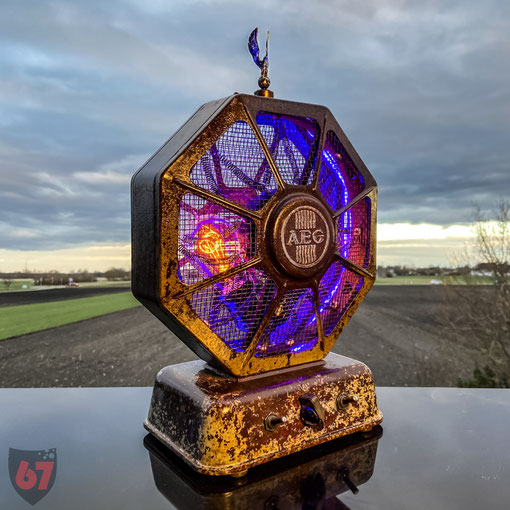
1937 AEG Fan Heater Upcycling Artwork
March 2021
This awesome fan heater has been built in 1937 by AEG in Berlin.
AEG had a pioneer of industrial design on board: Peter Behrens was a foundation member of the German Werkbund in 1907 and began designing for AEG - corporate design, type faces, logos, device cases and even entire factory buildings.
I preserved the rusty and rotten case with two layers of clear lacquer and sanded the embossed AEG logo for better visibility.
Inside, I installed two 100-year-old carbon filament bulbs. As these bulbs were for 110V, I had to connect them in series to the dimmer. The carbon filament is not very vulnerable, but the fusible nipple at the top of the glass bulb is. 50 Euro per bulb is no fun.
For the blue contrast light, I used two turns of LED COB stripes. Blue LEDs are also used to illuminate the silver eagle, a vintage figure for bonnets.
The contrast and mixture of the hot light of the glowing carbon filaments and the cold semiconductor light of LEDs is so fantastic.

1953 Tesla Talisman 308U Tuberadio Upcylcing Light Art
February 2021
The Tesla Talisman 308U from 1953 is one of the most beautiful tube radios in my opinion.
That’s why I thought twice about drilling holes in this beautiful Bakelit case. However, the radio and case was very damaged, so upcycling was just the right choice.
On top I placed four original Tesla vacuum tubes and illuminated them from below through the tube socket with super bright 5mm blue LEDs.
A brass sphere is the base for two E27 brass sockets that hold T300 Edison incandescent bulbs (300 mm length). Inside the tube radio I also installed several LEDs for lighting.
Tesla was a large, state owned electrotechnical company in the former Czechoslovakia. Originally founded in 1921, renamed to Tesla in 1946.
From 2007 to 2010, there was a trademark dispute between the original Tesla a.s. and the 2003 founded Tesla Motors Inc. but this has been solved with a contract.
You can find a solution for everything - even for a broken Tesla Talisman.
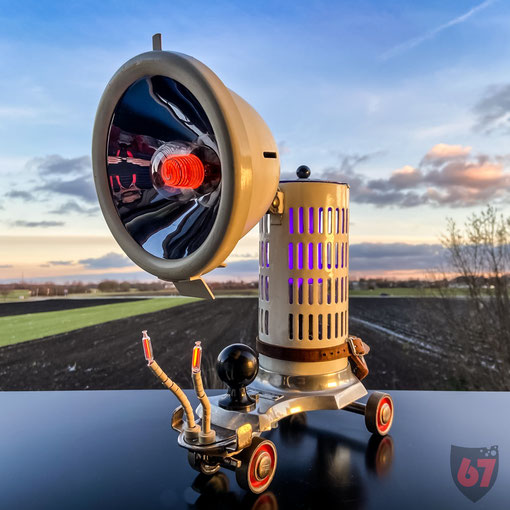
1950s Unisol Heilsonne Upcycling Light Art
December 2020
You can get roller skates in pairs, even if they are already 80 years old like these original Hudora roller skates. Here I have used the left roller skate - or was it the right one?
Hudora was founded in 1919 in Radevormwald / Germany by Hugo Dornseif and still produces roller skates, inline skates, skateboards and equipment for table soccer. More infos in Hudora can be found on the company history.
Anyway, a Unisol Heilsonne - healing sun - from the 1950s fits perfectly on the roller skate. I have integrated an LED UV blacklight into the enameled housing.
This gives great light effects through the slits of the round housing, which formerly contained a heating coil for Infrared radiation.
In the reflector was originally a carbon arc lamp for medical light treatments. A really hot part, but I replaced it with an old E27 socket and a special Bienenkorbglimmlampe - beehive neon glow bulb.
Two small glow bulbs sit in front like probes on wires protected with old small ceramic insulator hoses.
A great assemblage of old found objects into a luminous biomech robot on roller skates.

1940s Noris Piccolo film projector Upcycling Light Art
December 2020
I’ve always wanted to upcycle a film projector - and this little Piccolo simply captivated me.
It has been built in the 1940s by Noris Projektion GmbH in Nuremberg / Germany. It was specially made for Ozaphan films, which, unlikely Celluloid, were flame retardant and therefore suitable for children. They had to operate the film by hand with a
crank.
I used an old children’s film as a substrate for an LED stripe that I glued on both sides of the filmstrip. More infos on Noris can be found on filmkorn, a german site about Cine film.
Instead of the projection lens, I installed an E14 Bakelite socket and used a flicker glow bulb that represents the flickering of a film projector.
A perfect base for my object is an 80-year-old Hudora roller skate with cast iron wheels. The original leather strap that you used to strap the roller skate to your own shoes now ties up the Piccolo projector.
A captivating story indeed that my materials have here - now they are art for the ages.

1950s Rodos Heater Fan Upcycling Light Art
November 2020
Unfortunately I have not found anything about this 1950s Rodos heater fan in the web.
In the 50s such a lime green was quite popular - even our old bathroom had such tiles. In combination with gold, it really looks chic. What do you think?
First I fixed the fan motor, then I installed a remote controlled RGB LED stripe inside. But where to place my beloved Edison bulbs?
I decided to create aluminium holders for each side. They hold brass pulleys to hang the lamps on braided textile power cords. Antique brass lamp sockets with porcellain perfectly fit to the assemblage.
The Edison incandescent bulbs and the fan motor are connected to the dimmer switch.
A nice piece of garbage was turned into a spectacular piece of art that also provides impressive light and moving air.
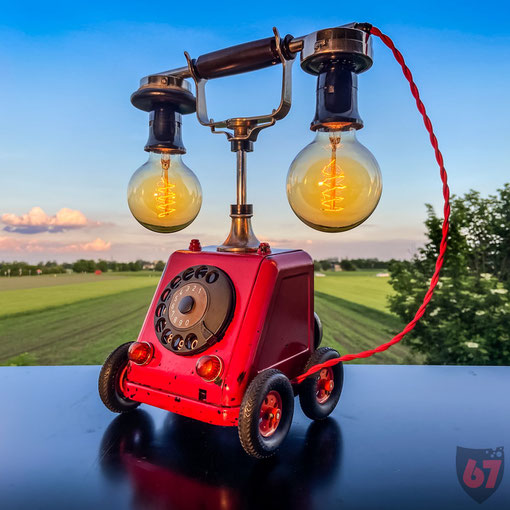
1919 Siemens & Halske Telephone Upcycling light object
May 2020
This old telephone by Siemens & Halske was developed from 1911 onwards, but was not mass-produced until end of World War I. From 1919 it was built as model ZB/SA 19.
Sometime in the last 100 years it received a stove-enamel finish in red. Maybe for the fire department or as an alarm phone.
The ZB/SA 19 (central battery operation/self-connection), was the first standard desk telephone of the German Reichs-Telegraphen-Verwaltung. Decisive for the successor ZB/SA 24, this telephone paved the way for self-connection, i.e. telephoning without a manual telephone operator in the central exchange office.
The device is one of the pre-war telephones, which were hardly affordable due to their complex and at that time advanced technology. It was used in government offices and by wealthy businessmen. It took many years before a telephone was introduced into private households. The workmanship of the ZB/SA 19 is so solid and durable that even after several years in a damp cellar it is still partially functional. The paint has been burned in, so the casing is less susceptible to rust.
I restored the device, added bakelite sockets, Edison incandescent bulbs, glow bulbs in the front, integrated a dimmer and added red textile power cords.
Finally four Märklin toy wheels with Dunlop tires complete it to a work of art.
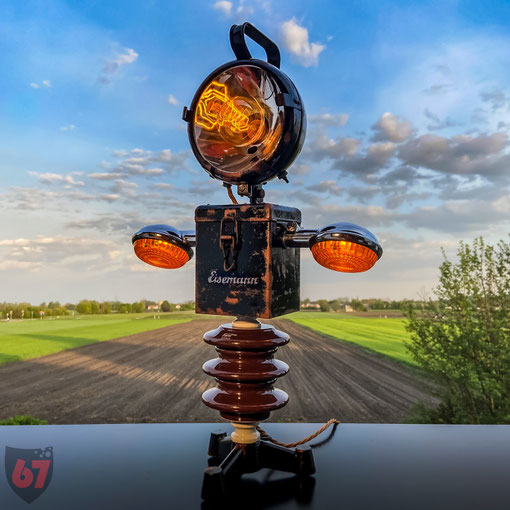
Eisemann handlamp Upcycling light object
March 2020
My rocket man consists of an old Eisemann hand lamp, two motorcycle flashers, ceramic insulators and a laboratory stand.
The Edison incandescent bulb is dimmable and the two motorcycle turn lights are illuminated with LED bulbs.
This Eisemann KB 130 hand lamp has been built in the early 1960s and was popular in the professional sector with fire brigades and army. It was used under critical conditions and was explosion-proof.
Ernst Eisemann founded this company around 1900 and was taken over by Bosch between 1925 and 1930. The company was located in Stuttgart, Rosenbergstr. 63.
Robert Bosch GmbH based in Stuttgart is today the world‘s largest automotive supplier.
Now my rocket man is ready to take off.

Thermosol sunlamp Upcycling light object
March 2020
I have created this upcycling artwork from these cool found objects:
- Thermosol sunlamp of the 1950s
- Aluminium hot water bottle from the 1920s
- Antique stroller wheels (60s?)
- Old Mercedes star (bought - not stolen)
- Tripod head
- Two old electron tubes
- Edison incandescent bulb
- Two blue cold cathode tubes
- Dimmer, textile power cord and bakelite plug
The electric stuff was complex because the cold cathode tubes need their own driver and power supply. This is all built into the housing of the sunlamp.
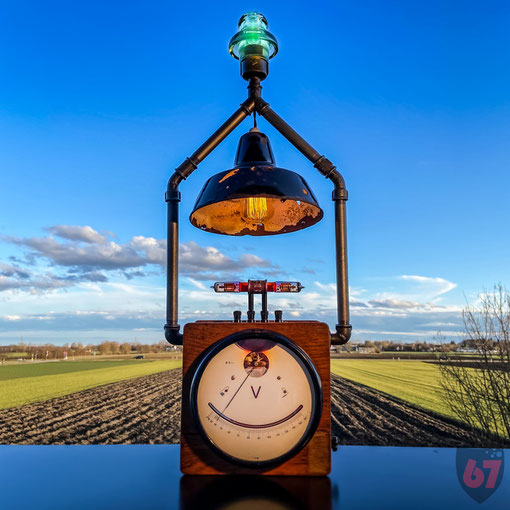
EAW Voltmeter Upcycling light object
February 2020
For this upcycling light object I used the following components:
A 1950s voltmeter by Elektro-Apparate-Werke in Berlin. In 1928 this company had about 4000 employees and became in the 50s one of the largest electrical companies in East Germany.
I have illuminated the wooden case and the gauge from inside with LEDs as well as both electron bulbs on the top.
I used 1/2 inch black tempered cast tubes and fittings to hold the lampshade.
The lampshade is black and white enamel with a lot of beautiful rust holes.
On the top I placed a green glass insulator which is illuminated by a green LED.
And of course the Edison bulb is dimmable.
Currently, any smile does you good, even from an old voltmeter
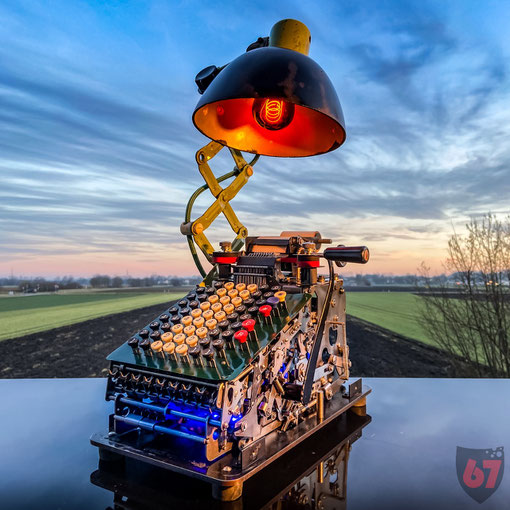
Continental 8 desk calculator Upcycling light object
February 2020
When I worked on this object, I knew very quickly that the inner life must remain visible.
This is a Continental 8 desk adding machine built by Wanderer-Werke in the 1930s.
Wanderer-Werke's biggest competitor was the US company Burroughs, whose mechanical calculating machines had been imported into Germany since 1895.
These adding machines are technical masterpieces and consist of hundreds of gears, racks, shafts and springs in a massive steel construction. The Continental 8 weighs a full 9 kg / 20 lb.
I cleaned the machine completely and repaired it as good as I could. In the core of the machine I installed a 12W LED COB module with a blue filter. This was a special challenge because I didn't want to disassemble the whole machine. These machines can be disassembled but never reassembled again without construction plan.
On the side I mounted an beautiful antique 1950s scissor desk lamp from the company Reif in Dresden. In the lamp I installed an old red light bulb. A textile cable in green matches it perfectly.
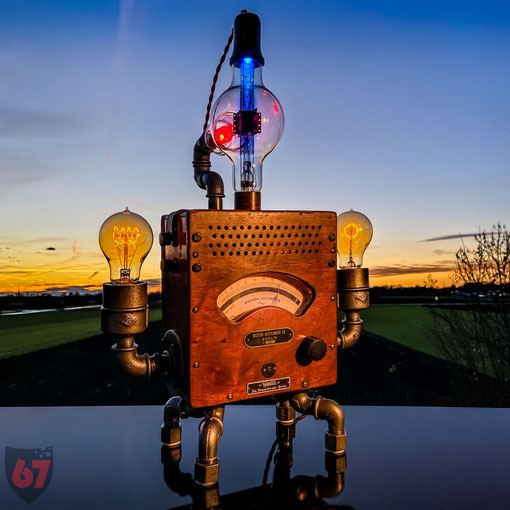
Weston Voltmeter and Westinghouse electron bulb Upcycling light object
January 2020
The antique Weston Voltmeter has been built in Berlin between 1900 and 1920. I restored the instrument which was in a bad condition.
On the top I placed a Westinghouse CWL-860 power tetrode electron tube. This beauty has been built from 1928 till the 1940s and has been used extensively in WW2 Navy transmitters, for example the TBL-12 transmitter.
I used a lot of blackheart malleable iron fittings in 1/2” to hold the tube, two Edison incandescent bulbs and to have a solid housing base.
I illuminated the oak housing from the inside with LEDs, as well as the electron tube from the top (in blue) and the back (in red). The light effects of this object are so fantastic in our living room.
The two Edison incandescent bulbs can be dimmed with the dimmer I placed on the front. Some time ago i bought a whole bag full of old bakelite knobs, so now i always have matching knobs.

1957 Philips Philetta 273 U tube radio upcycling
November 2019
This beauty is a Philetta 273 U tube radio. It has been built 1957 by Philips Germany.
Philips was founded in 1891 in Eindhoven/Netherlands and is now one of the largest electronics companies in the world.
Philetta radios have been built in approx. 70 model variants between 1941 and 1968.
My device was quite destroyed so it was ideal for my upcycling project. I restored the plastic housing, added bakelite lamp sockets, Edison incandescent tube bulbs, integrated a dimmer into the turning knop, LED illumination for the golden frontgrill. And I've added a Bluetooth module with an amplifier and connected it to the original speaker. The sound is due to the over 60-year-old speaker soft and smooth - just like the old tube radio.
What a revival!
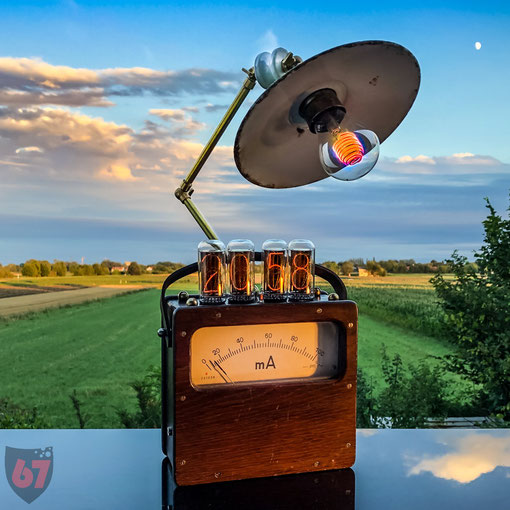
1930s Milliampermeter Nixie clock upcycling light object
August 2019
The components of my upcycling nixieclock-lamp-meter come from different decades in a period of 80 years:
1930s: an antique Milliamperemeter of an unknown manufacturer
1940s: the "Beehive" glow bulb has been built by Osram in WW2
1960s: a green-white enamel lampshade
1980s: four IN-18 Nixie tubes, manufactured in the Ukraine
2000s: brass rods and fittings
2010s: textile power cord and electronic circuits
I love Nixie tubes. Burroughs Corporation introduced in 1955 the "Numeric Indicator eXperimental No. I" = NIXIE.
The glass tube contains two type of electrodes: A wire mesh anode and 10 cathodes, shaped like the numerals 0 - 9. If you apply a electric power between anode and cathode the cathode will generate an orange glow discharge around its shape - the numeral. The tube is filled with neon and often a little bit argon and mercury. It is the same physical principle as with the beehive glow lamp.
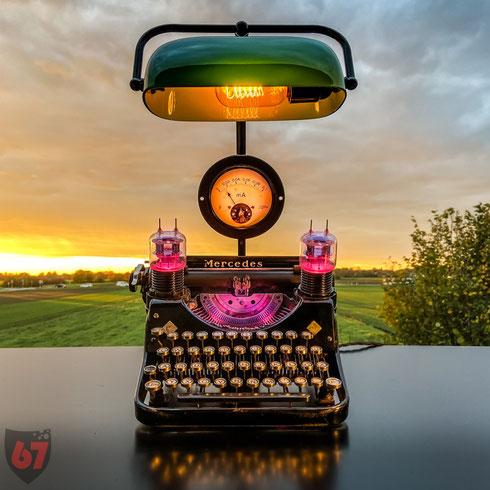
Mercedes Prima Mod. 34 typewriter upcycling lamp
July 2019
The Mercedes Prima Mod.34 typewriter has been manufactured by Mercedes Büromaschinen Werke, Zella-Mehlis in the year 1934.
I replaced the ribbon reels with two Valvo QQE04/20
double beam power tubes, which are illuminated by LED spots. The QQE04/20 double tetrode electron tubes have been used in the 1950/60s in HF amplifiers and oscillators for high frequency radio
communications.
There are also LED spots inside the housing to illuminate the typewriter mechanism.
An antique banker‘s lamp (I‘m a banker, too - but not antique) and an old Amperemeter turn the typewriter into a beautiful table lamp.
The first patent for a banker's lamp was filed on 11 May 1909 by Harrison D. McFaddin and were sold under the brand name Emeralite (green emerald and lite = light). The glass of the lamp shade consists of two layers: green colored outside, white inside. The lamp thus emits a subdued, unobtrusive light to the outside, while the reading material is sufficiently illuminated with white light.
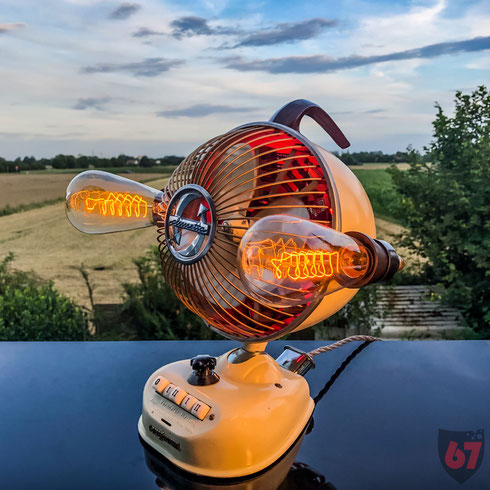
Maybaum Climetta fan upcycling light object
06/2019
This is a Maybaum Climetta 719 fan.
It has been built in the 1960s by the former company Maybaum
Elektrogeräte in Sundern, North Rhine-Westphalia, Germany. This company had its roots in the year 1797 (!) as a hammer mill.
The fan has two cold and two hot levels and the housing is made of metal with a bakelite handle.
I have refurbished the motor as well as the fan blades and preserved the original surface with clear paint.
In the fan housing I installed 3 red LEDs to simulate the heating. On the outside I constructed a mounting for two bakelite sockets for the Edison bulbs and finally added a small dimmer in the socket of the fan. The switch buttons allow to switch the fan motor, red LEDs and Edison lamp separately.
Instead of cold or warm air this beautiful antique piece now creates great light effects and has received a new life.



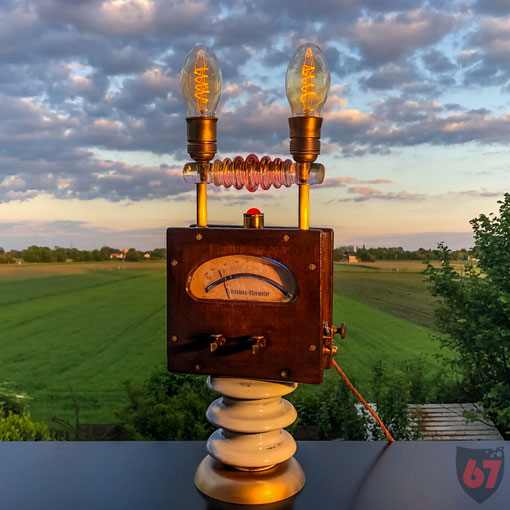
Gans & Goldschmidt Ohmmeter upcycling light object
05/2019
For this fantastic upcycling cocktail i have combined the following ingredients:
1) a beautiful 1920s Präzisions-Ohmmeter by Gans & Goldschmidt, founded 1897 in Berlin
2) a very rare glass insulator
3) two brass lamp sockets
4) two Edison incandescent bulbs
5) brass tubes
6) a red glass marble
7) parts of an old microscope
8) LED spot
9) blue filtered LED
10) an old porcelain insulator
11) a stainless steel desert bowl
12) Dimmer and switch
13) golden textile power cord
14) bakelite AC power plug




Bell Wheatstone Bridge upcycling lamp
05/2019
This historical device is a Wheatstone Bridge 7008A manufactured between 1930 and 1940 by Bell Telephone. It has been used to measure electrical resistance with extreme accuracy.
On the top I placed a rare and beautiful WW2 electron tube. It is a Telefunken RS 282 VIII shortwave radio tube. The tube has a power of 100 W and is heated with a voltage of 8 V. The tube has a
height of 245 mm or 10 inch. This type of tubes has been used in the radio transmitters of german submarines.
The print on the tube is on the front:
Telefunken
D.R.P. (=Deutsches Reichspatent)
RS 282 VIII
83504/078
And on the back:
Wehrmachtseigentum
a picture of the german Reichsadler
7. Aug 1938
I added bakelite sockets for two Edison filament bulbs, illuminated the electron tube from the top and from below with LEDs, illuminated the inside of the
wooden box and integrated a dimmer switch.
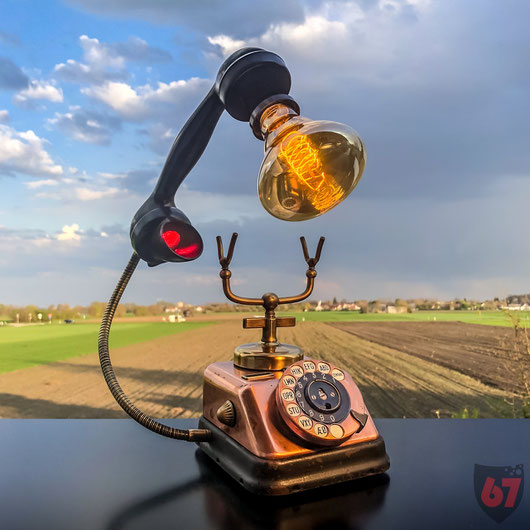
KTAS D30 telephone upcycling lamp
04/2019
This is a beautiful antique KTAS D30 telephone manufactured in the 1930s by Automatic Copenhagen / Denmark and refurbished in the 1960s by Expoga.
The handset is made of bakelite and the steel housing is plated with copper and brass.
I‘ve added a bakelite E27 socket, an Edison incandescent bulb, a red LED spot, a brass gooseneck to fix the handset, 2 neon glow bulbs, a dimmer and a textile power cord.
Finally I polished the copper and brass and sealed it with clear lacquer.
I have set the electromechanical tariff counter to ‚1604‘. This is day and month of a birthday cause my phonelamp was a very special birthday present in my family.



Kjøbenhavns Telefon Aktieselskab (KTAS) was founded in 1882 as one of the first telephone companies in Denmark to provide telephony to the public.
Around 1892 a young engineer and manufacturer Morton Balthazar Richter (1868 - 1943) started to produce telephones and developed new telephone parts. 1908 he became the main supplier of KTAS and renamed his company to Telefon Fabrik Automatic Copenhagen.

WW2 Feldmesskästchen VFD upcycling clock
03/2019
I‘ve upcycled an 1944 WW2 measuring device with an analog VFD clock display.
The „Feldmesskästchen 18“ was a small portable electrical measuring device and has been used in second world war by german signal corps.
The name "Feldmesskästchen 18" is derived from the fact that it was housed in a small wooden box and was introduced in its first version in 1918.
The beautiful analog clock is a VFD48 vacuum fluorescent display tube developed by Zhejiang BOE Display technology in the early 2000s. I added two neon glow bulbs, LED illumination for the
antique voltmeter and two old switches.
Inside the wooden box was just enough space to add a 5V power supply for the micro LEDs inside the meter and the VFD clock circuit.
The wooden box measures 15x11 cm, 6x4.3 inch.
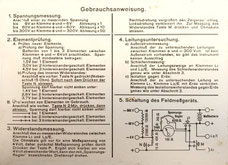
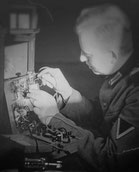

The Feldmesskästchen 18 had three basic tasks: Voltmeter, Ohmmeter and Line checks. It covered a wide spectrum in the German Wehrmacht. It was used by almost all troops.
The main field of application was, of course, telecommunications and radio technology.
My device has been manufactured by the company Gebr. Ruhstrat founded 1888 in Göttingen. Other manufacturers have been Josef Neuberger, P. Gossen and Schöller & Co.
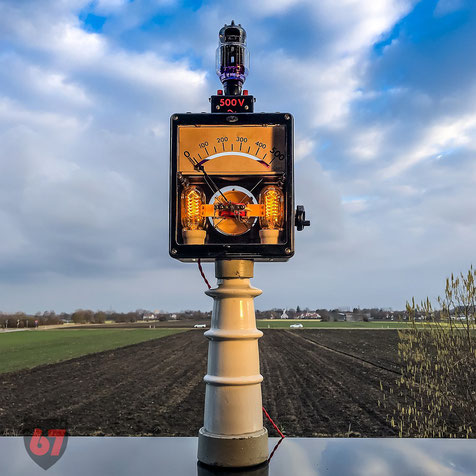
Phywe demonstration meter upcycling lamp
02/2019
This is a beautiful 1960s Phywe demonstration wattmeter used in schools and universities.
This Phywe meter is made of robust bakelite and has glass windows in front and back to show the scale to students and teacher. Inside the bakelite housing I placed two porcelain sockets, two Edison bulbs, in the back a violett filtered tube bulb and a dimmer. The violett light shines through the slot in the scale and illuminates the background of the objects. Unfortunately this is not visible on the picture.
As base I used a heavy (12 lb) high voltage insulator made of ceramic and cast iron of a transformer station.
On the top is a russian 6C33C electron tube, a double power triode. The tube has the nickname warthog due to the humps in the upper part of the tube. Originally it was built for the russian military and was used in the radio / transceiver of a MIG-25 fighter jet. Full story is here. This tube is nowadays one of the most beautiful tubes for HiFi tube amplifiers.
More Details on this russian power tube can be found at Jogis Roehrenbude.

The Phywe 7090 wattmeter is a demonstration measuring device for measuring the active power (real power) in DC and AC circuits. It is used in combination with up to ten interchangeable measuring range inserts.
Phywe has been founded in 1913 by Dr. Gotthelf Leimbach in Göttingen / Germany as a society for the exploration of the earth's interior. In 1918 the company was renamed to Physikalische Werkstätten GmbH and the production of physics teaching instruments was started.
Phywe is still one of the leading providers in this segment. If you like, have a look on the website of Phywe.

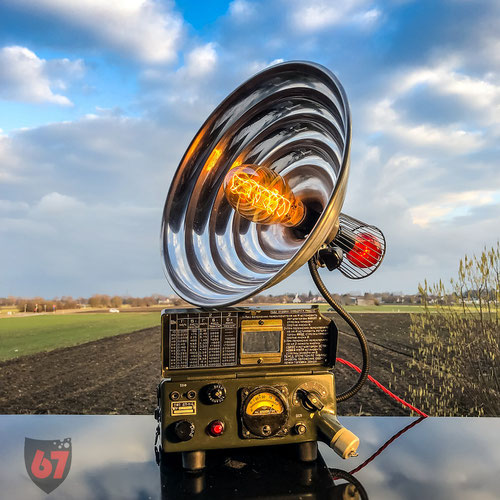
Military Beta-Gamma Geigercounter DP-11B upcycling lamp
02/2019
This Upcycling light object is made up of a military Beta-Gamma-Radiometer / Geiger counter built 1957 and parts of an old radiant heater.
A Geiger counter is used for detecting and measuring ionizing radiation. It is used for radiation dosimetry, radiological protection, experimental physics, and in the nuclear industry. It detects ionizing radiation such as alpha particles, beta particles, and gamma rays based on the ionization effect of the Geiger–Müller tube, which gives its name to the instrument.
Unfortunately the Geiger-Müller tube was missing on this instrument, when I bought it on ebay. On the right of the device, you can see the secured connection of the Geiger-Müller tube.
I removed the heater in the center of the reflector and added bakelite sockets for a red LED bulb in the rear and an Edison bulb in front. With a flexible gooseneck shaft I connected radiometer
and reflector. Because the gooseneck wasn't strong enough, I also inserted a 2mm copper wire. But it is still very wobbly.
On the panel of the radiometer I installed a AC dimmer/switch with the original turning knob and a red neon glow lamp.
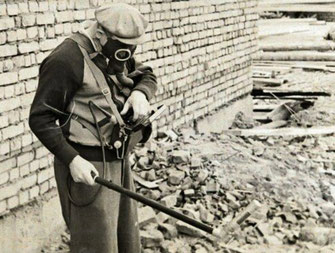
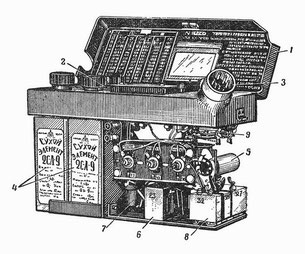
The radiometer type DP-11B has been built 1957 und was used to measure beta and gamma radiation. And it really meets military specifications- every gap is dust and waterproof sealed and erverything is shockproof secured.
The device has a carrying strap and the signal tones are heard with headphones. On the picture you see the Geiger-Müller tube on the end of a long stick.
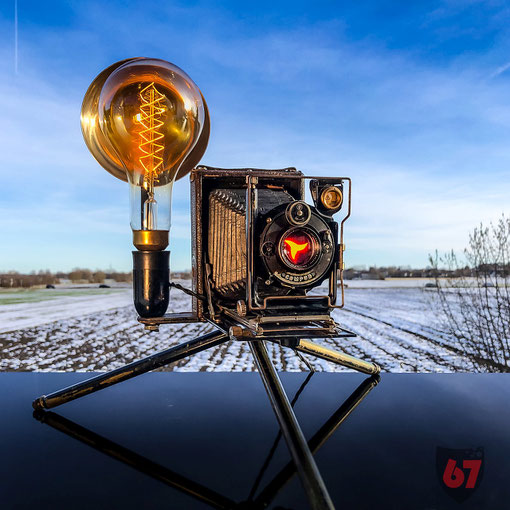
Antique folding camera upcycling lamp
02/2019
This is an antique 9x12 field/folding camera manufactured in the late 1920s by an unknown manufacturer. The Compur shutter has been made by the German company F. Deckel based in Munich. The shutter represents the most complicated part of this camera types.
I fixed the shutter in a half open position, so that you can see the aperture of the diaphragm. A diaphragm or leaf shutter has a number of thin blades which briefly uncover the camera aperture
to make the exposure. The blades slide over each other in a way which creates a circular aperture which enlarges as quickly as possible to uncover the whole lens, stays open for the required
time, then closes in the same way. More details on Compur shutters can be found on the Camera-Wiki.
Inside the beautiful leather bellows of the folding camera I placed a red LED spot. I used a LED in this place because it generates almost no heat.
Inside the small viewfinder I added a small neon glow bulb which is not visible on the photo but looks great through the magnifying glass of the viewfinder.
On the side of the camera I constructed a lamp holder like for a flash. The round mirror is an old stainless steel desert bowl and fits to the giant Edison bulb perfectly.

Friedrich Deckel AG, founded in 1903, was one of the largest German manufacturers of camera shutters and machine tools. The company was based in Munich.
Friedrich Deckel's own demand for high-precision machine tools for precision mechanics was largely met by Deckel himself. Such special machines were hardly for sale at that time and were therefore designed and manufactured by Deckel himself.
In 1953 the company employed 3000 people and from the end of the 1950s concentrated increasingly on machine tool manufacturing.
In 1961 the company changed its name to "Compur-Werk GmbH & Co.
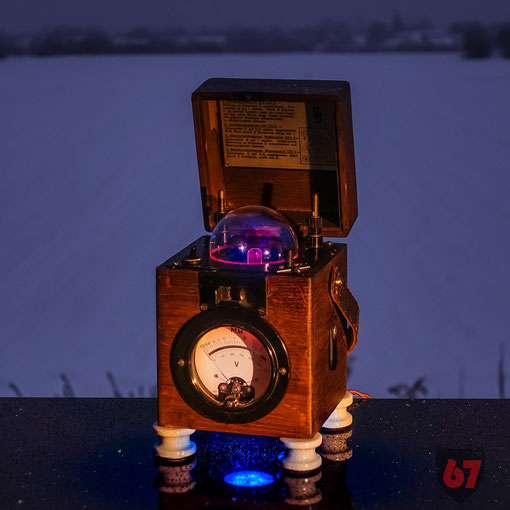
Siemens & Halske insulation meter upcycling light object
02/2019
I‘ve upgraded this antique measuring device quite a bit.
It has been built in the 1930s by Siemens & Halske in Berlin and been used to measure the electrical resistance or insulation with high voltages.
Inside the oak wood housing has been a magneto, an electrical generator, to produce 200 to 300 Volts AC when you turn the crank.
With this voltage you are able to check the isolation of an electrical installation.
I moved the gauge from the top to the front to have space for a 3“ plasma globe which perfectly fitted into the top hole.
A plasma globe is filled with a mixture of various noble gases (neon, argon, xenon, krypton) with a high-voltage electrode in the center of the sphere.
When high voltage is applied, a plasma is formed - Plasma filaments extend from the inner electrode to the outer glass insulator, giving the appearance of multiple constant beams of colored
light. The plasma lamp was invented by Nikola Tesla, during his experimentation with high-frequency currents in an evacuated glass tube. The modern plasma lamp design was subsequently developed
by Bill Parker, a student at MIT. More details in the Wikipedia
article.
I used porcelain insulators as feets. The oak wood housing is open at the bottom and a LED spot throws blue light on the ground.

This is a photo of the instruction manual attached to the inside of the wooden cover. It's written here:
1. Insulation measurement with 220V.
Connect test device to terminal C. Set changeover switch A to 1. Press button B and crank so quickly that the instrument pointer points to the red line. Release the button, continue cranking at
the same speed and read off the insulation value.
2. Insulation measurement with 110V.
Set change-over switch A to 0.5, divide read megohm value by 2, otherwise like 1.
3. Voltage measurement. Measuring range 250V.
Set switch A to 1. Connect unknown voltage to terminals C and read voltage value.
4. Voltage measurement. Measuring range 125V.
Set switch A to 0.5. Divide the read value by 2, otherwise like 3.

Hanau Sollux upcycling lamp
01/2019
This Original Hanau „Sollux“ was a red light lamp for infrared treatments built in the 1950s.
It has a beautifully designed housing in aluminum and phenolic resin / bakelite in a typical 50s streamline design.
I removed the original 150W lamp and the bajonet lamp socket and added an Edison filament bulb, an old E27 bakelite socket, a dimmer, two glow bulbs and two rubber wheels of an really old Märklin construction kit.
I tried to exchange the original on/off switch inside the curved bakelite holder of the the lamp with a dimmer. This was rather tricky due to limited space. For this reason I removed the potentiometer of the dimmer-board and placed it with long connecting wires into the curved holder of the lamp, the dimmer board remains in the bakelite base of the lamp.
Diameter: 120 mm. Height: 310 mm. Length: 320 mm. Width: 180 mm.

Antique wattmeter upcycling lamp
12/2018
This beautiful wattmeter has been built in the 1930s. It carries the serial number 0001 and an unknown logo of the letter S with wings on both sides. It could have been a company in the Siemens environment when they startet to build airplanes.
Due to the large glass pane i wanted to place the Edison lamp inside the wooden housing - so I had to reduce the size of the measuring device and place it 3 cm backwards. A real challenge, and it just worked for a small E14 bulb.
Originally two power sockets were mounted on the left side. By chance two old green glass insulators perfectly fitted into these holes.
On top of it I placed a JAN 576A Cetron electron tube. JAN tubes are Joint Army Navy tubes that were manufactured for the military.
The 576A is a high voltage (up to 25.000 Volts) rectifier tube produced by Cetron Electronic Corporation.
I removed the ceramic plate of the tube socket and illuminated it with a blue filtered LED bulb.
On both sides I placed copper coils from a relay and stainless steel balls from a curtain rod.
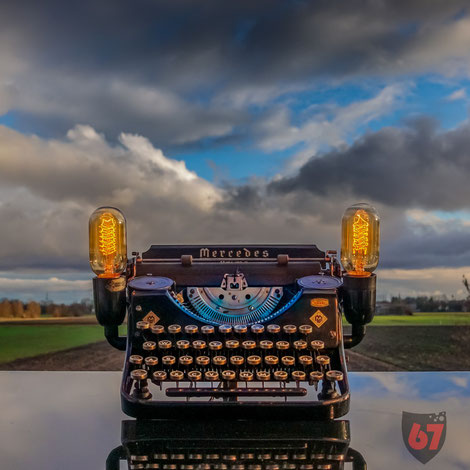
Mercedes Prima typewriter upcycling lamp
11/2018
This Mercedes Prima Mod. 34 typewriter has been manufactured by Mercedes Büromaschinen Werke in Zella-Mehlis Thüringen in 1934.
In 1906 the company has been founded by Dr. Gustav Mez in Berlin and moved in 1908 to Zella-Mehlis in Thüringen / Germany to start the production of Mercedes typewriters.
In 1931 the majority of the company was sold to the US Underwood Typewriter Company, NY City and these Mercedes Prima typewriters were Underwood machines that were assembled in Germany and fitted with a Mercedes sign.
There is very little free space in the machine to add lamps but I managed to place two blue filtered LEDs inside and two metal angle pipes and old E27 bakelite lamp sockets on both sides.
Nice Edison filament bulbs, a silver textile power cord and a dimmer complete this upcycling work.




1947 Copper telephone upcycling lamp
11/2018
When I saw this copper telephone i knew it would be my next great upcycling project.
The Belgian state telephone company, RTT asked her two suppliers, ATEA and BTMC to come up with a standard telephone together. This telephone has built 1947 by ATEA in Antwerp, Belgium. There are almost no original versions availabe - this one has the carrying handle of the RTT 56 A and the handset of the ATEAPHONE 50. Inside of the body a stamp shows the production year 1947.
The body is a 2.5 kg heavy Zamak metal die cast with copper surface. The dial is made of brass and the handset is massive bakelite. Built for eternity.
When I found this beautiful telephone on ebay copper and brass were corroded. With ox gall i could get the metals to shine again and preserved it with clear lacquer.
I have added bakelite lamp sockets, edison filament globe bulbs, a gooseneck to stabilize the handset, dimmer and a blue underfloor LED illumination, which unfortunately can only be seen in the very dark.


The body of the telephone is made of Zamak.
ZAMAK is a family of alloys with a base metal of zinc (Z) and alloying elements of aluminium (A), magnesium (MA), and copper (K) invented in the 1930s. On the surface the die-cast has been covered with copper.
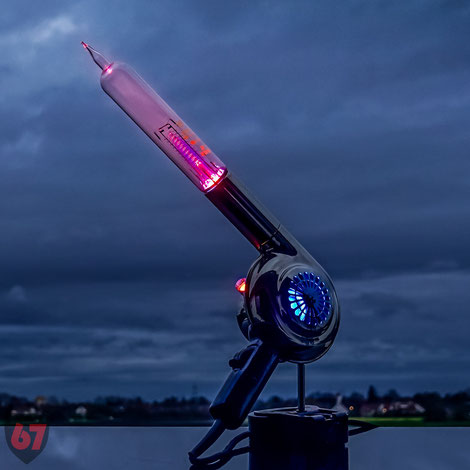
AEG hair dryer upcycling lamp
11/2018
My new raygun upcycling lamp.
I have used a 1950s AEG hair dryer - a beauty made of chrome and bakelite in a beautiful 50s design. Peter Behrens, a German architect and designer was for many years consultant for AEG and did the whole design of the corporate identity
and among others the basic design for the AEG hair dryers.
AEG (Allgemeine Elektricitäts-Gesellschaft) was a German producer of electrical equipment founded 1883 in Berlin. In the year 1900 AEG brought the first hair dryers onto the market.
Into the opening of the hairdryer a very special electron tube fitted. This historic hot-filament MR04 ionization gauge tube has been built in Berlin in the 50s too. It has been used to measure very low pressures in high-vacuum for the region from 0,0000000001 to 0,001 Torr.
I illuminated the tube from below with a LED spot and concentric red and blue filter foil. Within the hair dryer I integrated two neon glow lamps and a blue LED bulb.
The original switch and textile power cord was still ok, so it remained in place.




Astralux Baby artificial sun upcycling lamp
10/2018
This artificial sunlamp Astralux Baby has been built in the 1950s by Astralux Tiefenstrahler-Quarzlampen m.b.H. in Vienna / Austria. A really nice 50s design styling in tan and silver.
The sunlamp had a power of 400W and consisted of a UV quarz lamp and a circular infrared radiant heater. Heat and UV light could be switched seperately. In the base there was a mechanical timer with a bell.
I have removed the UV quartz lamp and the infrared heater and installed a porcelain socket, a nice Edison filament bulb and a coiled blue EL-wire (electroluminescence).
Additionally I have installed two LED illuminated electron bulbs and a dimmer for the Edison bulb.

Alpinette artificial sun upcycling lamp
07/2018
The basis of this upcycling project is a 1958 Original Hanau Alpinette PL25, an artificial sunlamp.
Original Hanau is still a leading manufacturer of artificial sunlamps, based in Hanau close to Frankfurt. In the year 1904 they invented the Ultraviolett high pressure lamps.
The nicely designed housing is made of aluminum and Phenoplast (phenolic resins - early plastics) and shows the fashionable aircraft design of the 50s.
I have removed the original UV quarzlamp and infrared radiators and added a porcelain socket, Edison filament bulb, blue LED illumination, two small glow bulbs, a dimmer and two beautiful old
rubber wheels of a Märklin construction set.
A real upgrade for this beauty.
Advertisement from Original Hanau dated July 1957:
The artificial sunlamp
Alpinette
Original Hanau
is used to increase performance and natural tonicity, normalize metabolism and prevent disease. Especially for children (rickets, anaemia, etc.) but also for curing colds, pain, rheumatism,
sciatica, etc.




Ultrakust Voltmeter upcycling lamp
05/2018
This Ultrakust Voltmeter has been built in the 1950s in Ruhmannsfelden/Bavaria.
The wooden case was painted with dirty gray lacquer. I sanded off the paint and painted the wood with a beautiful glaze to bring out the grain of the oak wood.
I have added parts of a vintage radiant heater, a beautiful russian electron tube, a dimmer, LED spot and 5 neon glow bulbs. The electron tube at the rear end of the reflector is illuminated by a red filtered LED spot and produces great red ambient light circles.
My light object uses lamps with 3 different physical methods of light generation:
1) Edison filament bulb with a wire heated to a temperature to glow with visible light.
2) Neon glow bulbs with a gas discharge at the electrodes.
3) LED with a semiconductor light emission.
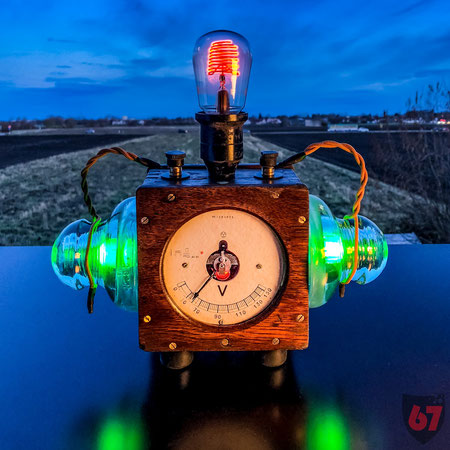
1930s AEG Voltmeter upcycling lamp with Bienenkorblampe
03/2018
The wooden case of this beautiful 1930s AEG Voltmeter was broken, so I first had to reconstruct the case, glue it and glaze it again.
Around 1917 the neon glow lamps have been invented some years after neon tubes got popular. These bulbs use a coronal discharge around two electrodes within a bulb filled with neon or argon noble
gas.
The special bulb I used is a so-called Bienenkorblampe or beehive bulb which is 80 years old and still working.
On top of the wooden case I installed a bakelite socket for the beehive bulb. On both sides I drilled big holes into the case to fit two vintage green glass insulators. I have illuminated the
glass insulators from the inside by two green LED spots.

Siemens & Halske Bakelite Amperemeter upcycling lamp
03/2018
This Amperemeter by Siemens & Halske, Berlin has been built in the late 1930s.
Really hard stuff: this instrument is made for electrical currents up to 200 Amperes - Inside I‘ve found thumb-thick copper conductors.
The housing is made of bakelite - an early plastic developed 1907 and often used due to its nonconductivity and heat resistance. The leather handle is sewn by hand.
On the left side of the bakelite housing I drilled three holes to mount the E14 sockets for three flicker glow bulbs.
On the right side I installed a dimmer - which does not work for the glow bulbs, but maybe I sometimes use Edison filament bulbs.
Four old wheels, LED backlight illumination complete this black bakelite device to a fiery beauty.

This brochure by Siemens Messtechnik is dated October 1938 and contains both table-top and portable measuring instruments.
My device has the list number 155863 and the original price was 140 RM (Reichsmark) which is about 560€ = 630$ today.


Zenit Quarz DS8M film camera upcycling lamp
02/2018
The mechanical 8mm camera Zenit Quarz DS8-M has been manufactured 1968 near to Moscow. When I auctioned this camera on ebay it came in a purple velvet lined imitation leather bag with many lenses and filters.
I modified this film camera with an old Iron-Hydrogenium Resistor Tube, which I illuminated through a hole in the socket.
Why did I choose violet light for this object? It‘s just cool in a dark mode and great spot color to black and blue.
The glass bulb isn’t an incandescent bulb in fact, it’s an old Iron-Hydrogen Resistor Tube formerly used in old tube radios. I removed the original socket and added an E14 LED spot array with a
violet filter foil.
Unfortunately it makes almost no light - just heat.
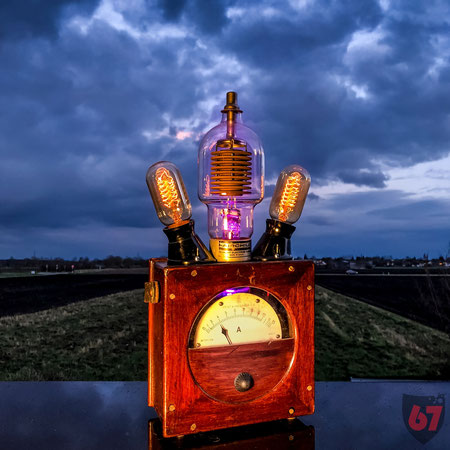
Amperemeter upcycling lamp
02/2018
The HIGHLIGHT of this light object is the awesome electron tube on top of the antique amperemeter.
It is a Fairchild 6303 high voltage radar clipper / rectifier electron tube made for up to 40.000 Volts and 2.5 A peak performance as a rectifier. It has a high vacuum inside and a graphite anode (the stack of discs) and a thoria-coated tungsten filament. Sounds impressive.
The tube is 245 mm / 9.65 inch long and is an artwork on its own. I opened the socket from below what really was a challenge and illuminated it with a violett filtered LED spot.
The antique Amperemeter by Voigt & Haeffner has been built in 1910 in Frankfurt and has a really nice Mahagoni wooden case.
The two Edison filament bulbs on angled bakelite sockets perfectly fit to this assemblage.
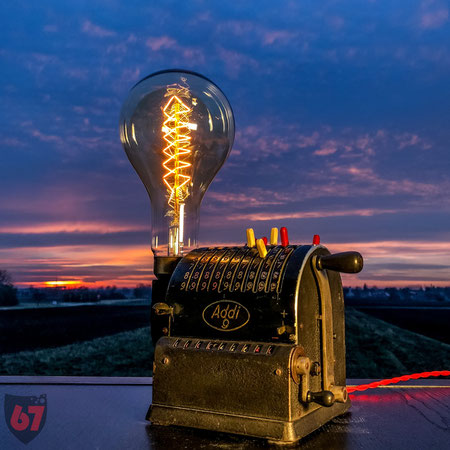
Lipsia Addi 9 mechanical calculator upcycling lamp
01/2018
I love antique mechanical calculating machines.
This is a 1930s Addi 9, built by Lipsia in Leipzig. Otto Holzapfel, born 1874 in Kassel, did initially an apprenticeship as a mechanic and founded 1914 the company Lipsia, which is the Latin name for Leipzig, to construct mechanical calculating machines.
1930 this Lipsia Addi 9 (= 9 digits) has been built and used for many years to perform additions and subtractions.
The price at that time was 120 Reichsmark, equivalent to today’s 500 Euro or 620 US-Dollar.
I‘ve integrated a red LED inside and a giant Edison bulb on the side of the calculator. The mechancal calculator still works - a miracle, because after disassembling I had dozens of gears, springs and axles in my hand.
I‘ve upcycled it 2018 to a nice table lamp.

Simpson Electric multimeter upcycling lamp
01/2018
The measuring device in a military green wooden case has been built by Simpson Electric Co., Chicago in the 1950s. A stamp on the housing indicates that it has been produced for the 22nd US Signal Brigade which was on mission in Korea war from 1951 till 1955.
Now my light object finally serves peaceful purposes.
A little unremarkable are the two very rare neon glow bulbs which I have installed on top of the old military measuring device. These bulbs are General Electric NE-34 built in the 1930s! With AC current the divided electrodes light up alternately 50 times per second. But the bulbs still work after 90 years of time.
An old bakelite socket for this beautiful edison bulb, a dimmer and a reflector from a vintage tanning lamp complete this assemblage.
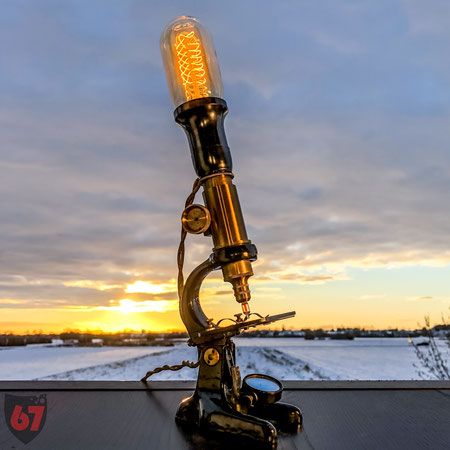
Microscope upcycling lamp
12/2017
This antique microscope is almost 100 years old.
I really like the contrast of golden brass and black cast iron. I’ve added a black bakelite socket, a golden Edison bulb, a small neon glow lamp and a golden textile power cord.
And finally the last ingredient, the golden glory of the sunrise - how dramatic.
I built this microscope desk lamp for my sister - she has been working in medical laboratories for many years.
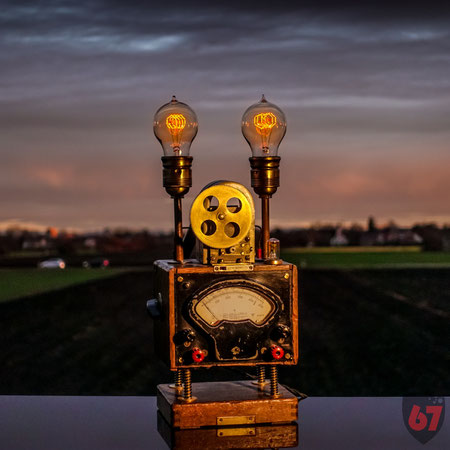
Insulation meter upcycling lamp
12/2017
In the 20s the electrification has increased more and more until in the 50s almost everything ran on electric power. This antique measuring device has been built in the 1930s and has been used the measure the insulation of electrical installations.
The manufacturer was GBD, Gebr. Bässler, Dresden / Germany an old company founded 1925 by Ernst Bässler.
The wooden box contained a hidden inductor engine, a generator to produce up to 400 volts when you turn the crank handle on the right side.
I installed the magneto top of the box together with brass sockets and beautiful edison filament bulbs.
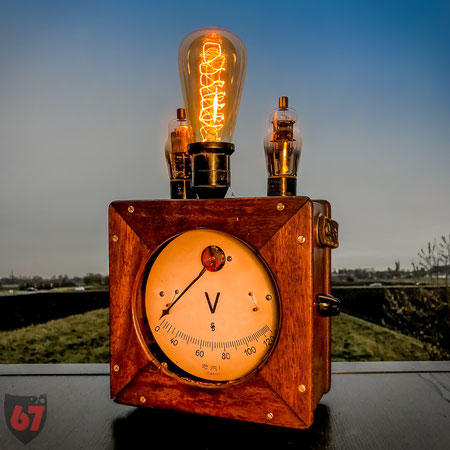
Siemens & Halske Voltmeter upcycling lamp
12/2017
This antique Voltmeter has been built in the 1920s by Siemens & Halske in Berlin.
It has a beautiful wooden case.
I illuminated the case with a red LED bulb from the inside. On top I placed a bakelite E27 socket for an Edison filament bulb and added two nice electron tubes.
On the right side I added a dimmer to dim the edison bulb.

